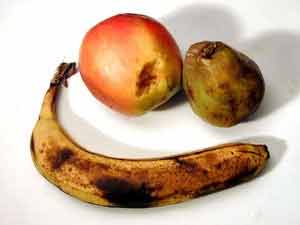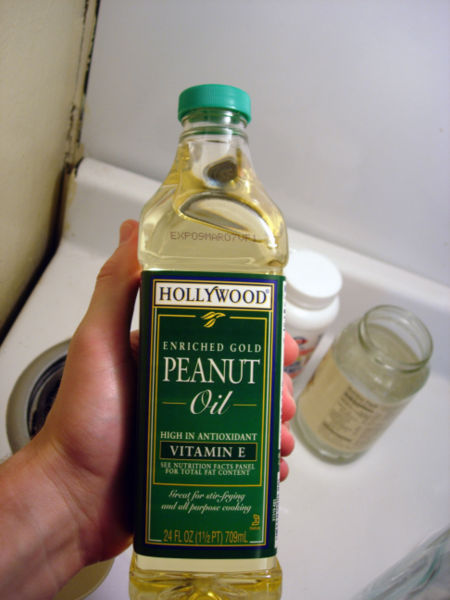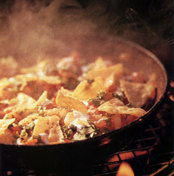Chef's Corner
Learning the fundamentals of cooking can impact a chef’s ability to drive levels of flavor, texture, color, and presentation to the plate. Most cooking fundamentals are based on classical French techniques. Those methods were taught to me at The Culinary Institute of America, and through my years of cooking, I have learned to apply the basics and develop some of my own techniques. Below are some definitions of important terms when referring to searing and sauteing.

Searing (or pan searing): is a technique used to cook the surface of food at a high temperature so that a caramelized crust forms. Searing is a process of cooking that creates the crusty surface texture most people find appealing and the caramelized sugars that gives us that steak flavor we want.

Dry Heat Cooking Method: Dry heat refers to cooking a food item uncovered without adding moisture and provides high retention of vitamins and minerals. It is normally done in a small amount of fat at a high temperature.
Caramelization: To heat sugar to its melting point, at which time it liquefies into a clear caramel syrup. Fruits and vegetablescan be grilled or roasted, roasted bell peppers for example, until the natural sugars turn to caramel and imbuse a sweet flavor.
 Maillard Reaction: This is a chemical reaction between the amino acid and a reacting sugar, usually requiring heat. Like carameliztion, it is a form of non-enzymatic browning. Many food scientists depend on this reaction to extract flavors that are imparted during the process, for use in fragrances or imitation flavorings.
Maillard Reaction: This is a chemical reaction between the amino acid and a reacting sugar, usually requiring heat. Like carameliztion, it is a form of non-enzymatic browning. Many food scientists depend on this reaction to extract flavors that are imparted during the process, for use in fragrances or imitation flavorings.
Browning: The term browning may refer to several different processes. The most common type of browning, also  known as the Maillard reaction, refers to a series of chemical reactions that makes foods from cookies to fried chicken and grilled steak taste and look more appealing. As the sugars in any food are heated, they change color from clear to dark brown and produce new flavor compounds. Browning is also an effective way to destroy surface bacteria on meats. A similar type of browning is known as caramelization. This is what happens to white sugar at high temperatures. Another, less desirable browning is what happens to certain fruits and vegetables when phenolic compounds in their flesh react with oxygen in the air to discolor the food. EX: Apples, bananas etc.
known as the Maillard reaction, refers to a series of chemical reactions that makes foods from cookies to fried chicken and grilled steak taste and look more appealing. As the sugars in any food are heated, they change color from clear to dark brown and produce new flavor compounds. Browning is also an effective way to destroy surface bacteria on meats. A similar type of browning is known as caramelization. This is what happens to white sugar at high temperatures. Another, less desirable browning is what happens to certain fruits and vegetables when phenolic compounds in their flesh react with oxygen in the air to discolor the food. EX: Apples, bananas etc.
Color, Flavor and Crust: During the searing process, we are achieving many things. Color is an important part of flavor development. The levels of flavors that are developed during searing and the caramelization process are not easily recreated. The texture of a crust is an important part of the finished products' mouth feel. To obtain the desired brown crust on meat, the surface must exceed 300 degrees, so searing requires the meat surface be free of water, which boils around 212 degrees.

Justus von Liebig
None the less, the purpose of searing is not to 'seal in the juices,' and if the product is cooked to the proper internal temperature and handled with care, it will be full of moisture and flavor.
Cooking Mediums: In order to sear something properly, some type of cooking medium is needed.  A cooking medium includes oils and fats that are used to begin the searing process. Cooking oil is purified fat of plant or animal origin, which is liquid at room termperature. Other fats that are often used to sear and saute with include: clarified and whole butter, coconut oil, duck fat, grapeseed oil, peanut oil, safflower oil, soybean oil, margarine, lard and all other vegetable oils. Each oil has a different smoking point and must be used accordingly.
A cooking medium includes oils and fats that are used to begin the searing process. Cooking oil is purified fat of plant or animal origin, which is liquid at room termperature. Other fats that are often used to sear and saute with include: clarified and whole butter, coconut oil, duck fat, grapeseed oil, peanut oil, safflower oil, soybean oil, margarine, lard and all other vegetable oils. Each oil has a different smoking point and must be used accordingly.
 Smoke Point: Refers to the temperature at which a cooking fat or oil begins to break down. The substance smokes or burns, and gives food an unpleasant taste. Beyond the smoke point is the flash point, the point at which combustion occurs. Peanut oil has a much higher smoke point than vegetable oil. Vegetable oil has a higher smoke point than whole butter. Butter contains milk solids that tend to burn fairly quick, so butter must be added at the right time.
Smoke Point: Refers to the temperature at which a cooking fat or oil begins to break down. The substance smokes or burns, and gives food an unpleasant taste. Beyond the smoke point is the flash point, the point at which combustion occurs. Peanut oil has a much higher smoke point than vegetable oil. Vegetable oil has a higher smoke point than whole butter. Butter contains milk solids that tend to burn fairly quick, so butter must be added at the right time.
Fond/Deglazing: A fond is created in the bottom of a pan during the searing/browning process. It is all the residual sugars  that have caramelized to the pan. The untrained cook may look at that as a dirty pan and simply wash it and put it away. But to the aspiring chef, that leftover goodness is VERY flavorful, and can be used as the base for a delicious sauce. In order to lift those flavors back up off the pan, the art of 'deglazing' is needed. Choose your favorite alcohol or stock and add it to the pan then put it back on the flame. This requires some agitation, but the fond will lossen up and all of those well developed flavors are ready to use! Season with aromatics and possibly butter, reduce to desired consistency, and your wonderful pan sauce is complete.
that have caramelized to the pan. The untrained cook may look at that as a dirty pan and simply wash it and put it away. But to the aspiring chef, that leftover goodness is VERY flavorful, and can be used as the base for a delicious sauce. In order to lift those flavors back up off the pan, the art of 'deglazing' is needed. Choose your favorite alcohol or stock and add it to the pan then put it back on the flame. This requires some agitation, but the fond will lossen up and all of those well developed flavors are ready to use! Season with aromatics and possibly butter, reduce to desired consistency, and your wonderful pan sauce is complete.
Choosing the Best Ingredients: Always purchase your ingredients from a reputable purveyor or market. Home grown vegetables and herbs are the best and ensure freshness. For seafood, meat and poultry, it isimportant to inspect them for discoloration, unpleasant odors, and any unwanted markings on the exterior. Ask the right questions to ensure quality and freshness, and don't be shy to turn away any product you are unhappy with.
Preparing Meat, Fish and Poultry for Searing: Portion size is important when deciding what type of pan to sear in. Next step is to dry the product of any excess moisture. The more moisture present, the more difficult it will be to achieve that perfect sear, so pat it dry with a paper towel. Even seasoning should be done next. I tend to season the top, bottom and sides of each protein, depending on its size.
 Sauteing: is a method of cooking food that uses a small amount of fat in a shallow pan over relatively high heat. Unlike pan-searing, sautes are often finished with a sauce made from the pan's residual fond. Food that is sauteed is usually cooked for a realtively short period of time over high heat, with the goal of browning the food while preserving its color, moisture and flavor. This is very common with more tender cuts of meat, e.g. tenderloin, pork chops or filet mignon.
Sauteing: is a method of cooking food that uses a small amount of fat in a shallow pan over relatively high heat. Unlike pan-searing, sautes are often finished with a sauce made from the pan's residual fond. Food that is sauteed is usually cooked for a realtively short period of time over high heat, with the goal of browning the food while preserving its color, moisture and flavor. This is very common with more tender cuts of meat, e.g. tenderloin, pork chops or filet mignon.
Choosing the Right Pan: The best pan for sauteing and making a pan sauce would be a heavy bottomed, non reactive saute pan. The desirable fond that is created in the pan, cannot easily be achieved in a non sitck pan. Size is everything...Whenever you are sauteing anything, you want to  make sure you give the meat, chicken or fish enough room in the pan to allow it to sear and to prevent steaming. Rule of thumb is leave at least 1/4 to 1/2 inch between pieces. On the other hand, you don't want a pan that's too big or the ingredients have a tendency to burn. A 9 or 10 inch pan works well for at home. There are many different kinds of pans on the market from cast iron, to calphalon, to every celebrity chef's newest marketing adventure. It solely comes down to quality and personal preference.
make sure you give the meat, chicken or fish enough room in the pan to allow it to sear and to prevent steaming. Rule of thumb is leave at least 1/4 to 1/2 inch between pieces. On the other hand, you don't want a pan that's too big or the ingredients have a tendency to burn. A 9 or 10 inch pan works well for at home. There are many different kinds of pans on the market from cast iron, to calphalon, to every celebrity chef's newest marketing adventure. It solely comes down to quality and personal preference.
Differences Between Sauteing and Searing: Sauteing differs from searing in that the sauteed food is thoroughly cooked in the process. One may sear simply to add flavor and improve appearance before another process is used to finish cooking it.
Hear the Music (Sizzle): To ensure the right temperature and amount of fat are being used during the saute process, listen for the sizzle. If no 'music' is heard, then the sauteing most likely hasn't begun. Adjust the termperature of your pan, or add more fat.
Cut, Size and Timing: Not all vegetables will cook at the same time. For example, a root vegetable (such as a carrot) and an eggplant, both have different textures and water content. If they are both cut to the same size and shape and entered into the hot pan simultaneously, the eggplant will be overcooked by the time carrot is tender. Knowing your vegetables and their water content will help you determine who goes in the pan first. If a vegetable needs less time to thoroughly cook, then add it towards the end of the sauteing process. Timing is everything with cooking, and knowledge is power!
 Turning and Tossing (Jumping): Sauter in French means "To Jump." It refers to flipping the food in the air. This is necessary to ensure even cooking without breaking up the food by agitating it with foreign objects, such as spoons and tongs. Practice makes perfect, so figure out which hand you have more control with and begin. A great tip for practicing, is to take a cold pan, put a handful of beans or rice in the pan, and push the weight of the pan forward so that all the food falls to the front of the pan. In one swift movement, pull the pan towards you and rotate your wrist upward, forcing the food to flip in the air. If the wrist movement isn't done at the right time, all of your food will fly forward onto the floor before it sets flight. Lastly, accept the food back in the pan as if you were trying to catch an egg, with care and concern.
Turning and Tossing (Jumping): Sauter in French means "To Jump." It refers to flipping the food in the air. This is necessary to ensure even cooking without breaking up the food by agitating it with foreign objects, such as spoons and tongs. Practice makes perfect, so figure out which hand you have more control with and begin. A great tip for practicing, is to take a cold pan, put a handful of beans or rice in the pan, and push the weight of the pan forward so that all the food falls to the front of the pan. In one swift movement, pull the pan towards you and rotate your wrist upward, forcing the food to flip in the air. If the wrist movement isn't done at the right time, all of your food will fly forward onto the floor before it sets flight. Lastly, accept the food back in the pan as if you were trying to catch an egg, with care and concern.
Learn, practice and perfect these skills, and you'll be unstoppable in the kitchen! Cooking can be very scientific, but knowing the 'whys' of cooking will ensure that when a mistake is made, it can be fixed.
Good Luck and Good Eating!
Chef Brian


